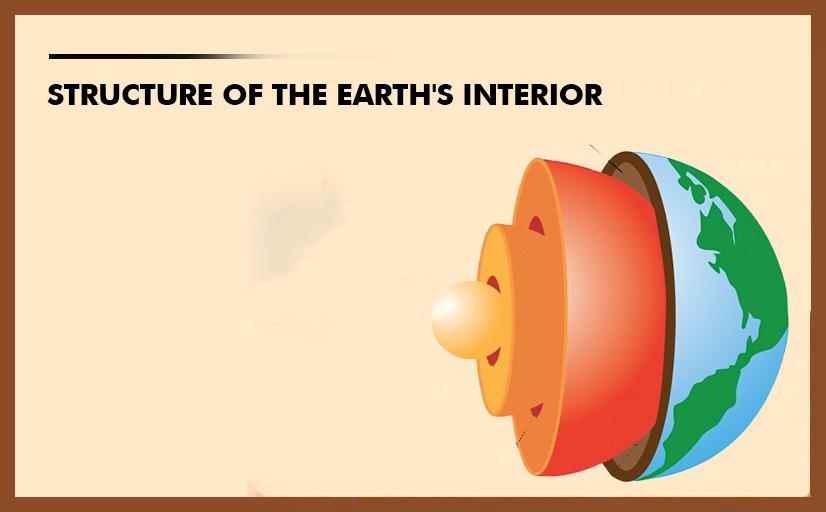
Structure of the earth's interior
The crust, mantle, and Core comprise the three basic layers of the earth's interior structure.
Structure of the earth's interior

The crust, mantle, and Core comprise the three basic layers of the earth's interior structure.
Crust
- The earth's outermost solid region is typically 8 to 40 kilometres thick.
- Its nature is brittle.
- The crust makes up almost 1% of the earth's volume and 0.5% of its mass.
- Oceanic and continental regions have different crustal thicknesses. Compared to the continental crust, which is about 30 km thick, the oceanic crust is only about 5 km thick.
- Silica (Si) and aluminium (Al) are two of the main components of the crust, which is why it is frequently referred to as SIAL (sometimes SIAL is used to refer to the Lithosphere, which is the region made up of the crust and uppermost solid mantle, as well).
- The crust's materials have an average density of 3g/cm3.
- It is known as the Conrad Discontinuity when there is a separation between the hydrosphere and crust.
Mantle
- The mantle is the area of the interior that lies above the crust.
- The crust-mantle separation is referred to as the Mohorovich Discontinuity or Moho discontinuity.
- The mantle has a thickness of about 2900 km.
- The earth's mantle makes up nearly 84% of its volume and 67% of its mass.
- The mantle is also known as SIMA because it primarily consists of silicon and magnesium.
- The layer's density ranges from 3.3 to 5.4g/cm3 and is higher than the crust.
- The Lithosphere comprises the entire crust and the uppermost solid portion of the mantle.
- Just below the Lithosphere, in the upper mantle, is the asthenosphere, which is highly viscous, weak mechanically, and ductile.
- According to plate tectonics, the asthenosphere is the principal source of magma and the layer over which continental and lithospheric plates move.
- Repetti Discontinuity describes the separation of the upper and lower mantles.
- Mesosphere refers to the region of the mantle that lies just above the Core and above the Lithosphere and asthenosphere.
Core
- It is the outermost layer encircling the centre of the earth.
- Guttenberg's Discontinuity divides the mantle from the Core.
- It is also known as NIFE because its primary ingredients are nickel (Ni) and iron (Fe).
- Nearly 15% of the earth's volume and 32.5 percent of its mass are composed of the Core.
- The earth's Core is the densest layer, ranging from 9.5 to 14.5 grams per cubic centimetre.
- The inner and outer Core are the two sub-layers that make up the Core.
- The Inner Core is in a state of solidity, while the outer Core is liquid (or semi-liquid).
- The Lehmann Discontinuity separates the upper Core from the lower Core.
- The term "barysphere" can refer to the entire earth's core interior.
Interior Earth's Temperature, Pressure, and Density
Temperature
-
Temperature increases in mines and deep wells as depth increases.
- The fact that the temperature rises toward the earth's centre is supported by this evidence and the molten lava that has erupted from within.
- The various observations demonstrate that the rate of temperature increase is not constant as one moves from the surface to the earth's centre. In some places, it moves more quickly than in others.
- This temperature increase starts at an average rate of 10C for every 32m increase in depth.
- While the temperature rises by 120C per km in the upper 100km and 200C per km in the following 300km, respectively, the rate drops to just 100C per km as you go deeper.
- The rate of increase of temperature beneath the surface is therefore decreasing toward the centre. From the earth's surface to its interior, the temperature rises continuously.
- The temperature at the centre is thought to range between 30,000°C and 50,000°C, possibly even higher because of the chemical reactions taking place under high pressure.
- Because of the intense pressure from the materials above, the materials at the earth's centre are in a solid state even at such a high temperature.
Pressure
- The pressure rises from the earth's surface toward its centre in a similar manner to how the temperature is.
- The heavy materials above, like rocks, are to blame for this.
- According to estimates, the pressure in the deeper parts is extremely high and will be roughly 3–4 million times greater than the pressure of the atmosphere at sea level.
- The materials below will melt toward the earth's centre at high temperatures, but under pressure, they become solid and probably exist in a plastic state.
Density
- The denser the earth's layers become as you move toward the centre because of rising pressure and the presence of heavier elements like nickel and iron.
- From the crust to the Core, the average layer density keeps rising until it reaches almost 14.5g/cm3.
